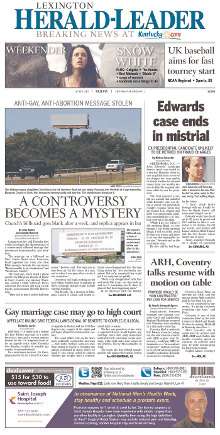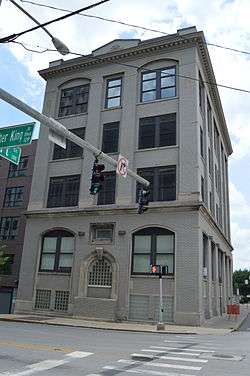Lexington Herald-Leader
The Lexington Herald-Leader is a newspaper owned by The McClatchy Company and based in the U.S. city of Lexington, Kentucky. According to the 1999 Editor & Publisher International Yearbook, the Herald-Leader's paid circulation is the second largest in the Commonwealth of Kentucky. The newspaper has won the 1986 Pulitzer Prize for Investigative Reporting, the 1992 Pulitzer Prize for Editorial Writing and the 2000 Pulitzer Prize for Editorial Cartooning.[3] It had also been a finalist in six other Pulitzer awards in the 22-year period up until its sale in 2006, a record that was unsurpassed by any mid-sized newspaper in the United States during the same time frame.[4]
 The June 1, 2012 front page of the Lexington Herald-Leader | |
| Type | Daily newspaper |
|---|---|
| Format | Broadsheet |
| Owner(s) | The McClatchy Company[1] |
| Editor | Peter Baniak |
| Staff writers | 143 |
| Founded | 1870 (as the Lexington Daily Press) |
| Headquarters | 100 Midland Avenue Lexington, Kentucky 40508 United States |
| Circulation | 55,833 Daily 63,458 Sunday (as of 2013)[2] |
| ISSN | 0745-4260 |
| Website | Kentucky.com |
History

The Herald-Leader was created by a 1983 merger of the Lexington Herald and the Lexington Leader. The story of the Herald begins in 1870 with a paper known as the Lexington Daily Press. In 1895, a descendant of that paper was first published as the Morning Herald, later to be renamed the Lexington Herald in 1905. Meanwhile, in 1888 a group of Fayette County Republicans began publication of a competing afternoon paper named the Kentucky Leader, which became known as the Lexington Leader in 1901.[5]
In 1937, the owner of the Leader, John Stoll, purchased the Herald.[5] The papers continued as independent entities for 46 years. Despite the common ownership, the two papers had different editorial stances; the Herald was moderately liberal while the Leader was conservative. The two newspapers published a combined Sunday edition. In 1973, both were purchased by Knight Newspapers, which merged with Ridder Publications to form Knight Ridder the following year.[4] A decade later, in 1983, the Herald and Leader merged to form today's Lexington Herald-Leader.[3] In 1985, publisher Creed Black allowed reporters to publish a series of articles which exposed widespread corruption within the University of Kentucky's Wildcats men's basketball team.[6] From 1979 to 1991, the paper was edited by John Carroll, who went on to edit The Baltimore Sun and the Los Angeles Times.
On July 11, 2001, the paper reduced four positions due to declining advertising revenue and higher newsprint costs.[7] Long-time columnists Don Edwards and Dick Burdette took voluntary early retirements but are still published occasionally as contributing writers. The job eliminations were a cumulation of efforts that started in May when the workforce was reduced by 15 positions.[7]
On July 4, 2004, the newspaper, in an effort to apologize for failing to cover the civil rights movement, published a front-page package of stories and archive photos documenting Lexingtonians involved in the movement.[3] The stories, written by Linda B. Blackford and Linda Minch, received international attention, including a story on the front page of The New York Times. It also received an annual professional award by the Kentucky chapter of the Special Libraries Association.
On June 27, 2006, the McClatchy Company purchased Knight Ridder for approximately $4 billion in cash and stock on June 27, 2006.[8] It also assumed Knight Ridder debt of $2 billion. McClatchy sold 12 Knight Ridder papers, but the Herald-Leader was one of 20 retained.
Office and production plant
The Herald-Leader's new office and production plant facility was completed in September 1980 at a cost of $23 million.[9] It was a 158,990 square feet (14,771 m2) structure that featured 14 Goss Metro offset presses that had the capacity to produce 600,000 newspapers in a typical week.
The plant is on a 6-acre (24,000 m2) lot at the corner of East Main Street and Midland. The $23 million cost was divided into $7,804,000 for architecture, $750,000 for interiors and $8,500,000 for production equipment and presses.
In June 2016, it was announced that the Herald-Leader would cease its printing operations in Lexington, passing that role to Louisville-based Gannett Publishing Services. As a result of the move, 25 full-time and 4 part-time employees would be laid-off. It was also announced that the plant would be put up for sale, with the Fayette County property valuation administrator assessing the property at $6.84 million for tax purposes. The first issue of the Louisville-printed Herald-Leader published on August 1, 2016.[10] The last issue of the Lexington Herald-Leader to be printed in Lexington was printed on July 31, 2016. It marked the end of 229 years of newspaper printing in Lexington.[11]
The Herald-Leader building has been proposed as a new city hall for the Lexington-Fayette Urban County Government.[12] Remaining staff will be relocated to a smaller office space upon the sale of the building.
See also
- The Courier-Journal – Kentucky's largest newspaper
- List of newspapers in Kentucky
References
- "Our Markets". Sacramento, California: McClatchy Company. Retrieved March 26, 2017.
- "The McClatchy Company 2013 Annual Report" (PDF). The McClatchy Company. March 24, 2014. Retrieved June 9, 2014.
- "Lexington Herald-Leader". The McClatchy Company. Retrieved May 21, 2007.
- Kelly, Tim (June 27, 2006). "Knight Ridder contributed to journalism, community". Lexington Herald-Leader. p. A13.
- Carter, Lisa. "John C. Wyatt Lexington Herald-Leader Collection". Retrieved March 2, 2007.
- Martin, Douglas (August 17, 2011). "Creed C. Black, Newspaper Executive, Dies at 86". The New York Times. Retrieved August 21, 2011.
- "Veteran Herald-Leader columnists take early retirement". Lexington Herald-Leader. July 12, 2001. p. B1.
- Sloan, Scott (June 27, 2006). "Herald-Leader Joining McClatchy". Lexington Herald-Leader. Retrieved May 21, 2007.
- Mastiff, Bruce. "Outward Bound – Landlocked Lexington Survives and Grows." Kentucky Monthly 2.3 (1981)."
- "Lexington Herald-Leader to be printed in Louisville, will put downtown building on market". Lexington Herald-Leader. June 27, 2016. Archived from the original on June 28, 2016. Retrieved July 10, 2016.
- "Presses roll final time as newspaper printing moves to Louisville". Lexington Herald-Leader. July 30, 2016. Archived from the original on August 1, 2016. Retrieved August 1, 2016.
- "Committee selects Herald-Leader building for new city hall. What the plan includes". kentucky. Retrieved July 13, 2018.
External links
- Lexington Herald-Leader official site
- Lexington Herald-Leader mobile site
- The McClatchy Company's subsidiary profile of the Lexington Herald-Leader
- John C. Wyatt Lexington Herald-Leader photographs collection, University of Kentucky Libraries Special Collections Research Center
- James Edwin Weddle photographic collection, University of Kentucky Libraries Special Collections Research Center